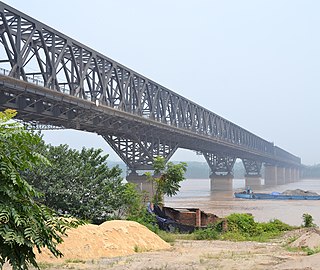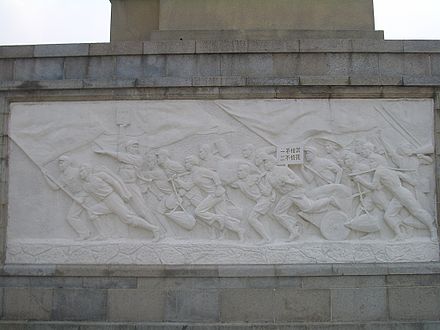
The YangtzeRiver, which is 6,380 km (3,964 mi) long, is the longest river in Asia and the third-longest in the world. The river is the longest in the world to flow entirely within one country. It drains one-fifth of the land area of the People's Republic of China (PRC) and its river basin is home to nearly one-third of the country's population. The Yangtze is the sixth-largest river by discharge volume in the world.

The Yellow River or Huang He is the second longest river in China, after the Yangtze River, and the sixth longest river system in the world at the estimated length of 5,464 km (3,395 mi). Originating in the Bayan Har Mountains in Qinghai province of Western China, it flows through nine provinces, and it empties into the Bohai Sea near the city of Dongying in Shandong province. The Yellow River basin has an east–west extent of about 1,900 kilometers (1,180 mi) and a north–south extent of about 1,100 km (680 mi). Its total drainage area is about 752,546 square kilometers (290,560 sq mi).

Yichang is a prefecture-level city located in western Hubei province, China. It is the second largest city in the province after the capital, Wuhan. The Three Gorges Dam is located within its administrative area, in Yiling District. As of the 2010 census, its population was 4,059,686 inhabitants whom 1,350,150 lived in the built-up area made of Yiling, Xiling, Wujiagang and Dianjun urban districts as Xiaoting District is not urbanized yet.
The Banqiao Reservoir Dam is a dam on the River Ru in Zhumadian City, Henan province, China. Its failure in 1975 caused as many as 230,000 deaths. The dam was subsequently rebuilt.

The 1931 China floods or the 1931 Yangtze-Huai River floods were a series of devastating floods that occurred in the Republic of China. They were some of the deadliest floods in history, and together formed one of the most lethal natural disasters of the 20th century, excluding pandemics and famines. Estimates of the total death toll range from 422,499 to between 3.7 million and 4 million.

The Qing River is a right (southern) tributary of the Yangtze River in Hubei province of south-central China.

The South–North Water Transfer Project, also translated as the South-to-North Water Diversion Project is a multi-decade infrastructure mega-project in the People's Republic of China. Ultimately it aims to channel 44.8 billion cubic meters of fresh water annually from the Yangtze River in southern China to the more arid and industrialized north through three canal systems:

Shennong Stream is a left tributary of the Yangtze River, located in the Hubei Province of central China. Fed by tributaries some of which come from the Shennongjia Forestry District, the stream flows south, falling into the Yangtze opposite the city of Badong.

The Wuhan Yangtze Great Bridge, commonly known as Wuhan First Yangtze Bridge, is a double-deck road and rail bridge across the Yangtze River in Wuhan, in Central China. At its completion in 1957, the bridge was the easternmost crossing of the Yangtze, and was often referred to as the "First Bridge of the Yangtze".

The Xiluodu Dam is an arch dam on the Jinsha River, i.e. the upper course of the Yangtze in China. It is located near the town of Xiluodu in Yongshan County of Yunnan Province but the dam straddles into Leibo County of Sichuan Province on the opposite side of the river. The primary purpose of the dam is hydroelectric power generation and its power station has an installed capacity of 13,860 MW. Additionally, the dam provides for flood control, silt control and its regulated water releases are intended to improve navigation downstream. Construction on the dam and power station began in 2005 and the first generator was commissioned in 2013, the last in 2014. It is operated by China Yangtze Power and is currently the third-largest power station with the fourth-tallest dam in the world.

The baiji is a functionally extinct species of freshwater dolphin formerly found only in the Yangtze River in China. Nicknamed "Goddess of the Yangtze" in China, the dolphin is also called Chinese river dolphin, Yangtze River dolphin, whitefin dolphin and Yangtze dolphin. It was regarded as the goddess of protection by local fishermen and boatmen in China. It is not to be confused with the Chinese white dolphin or the finless porpoise.

The bridges and tunnels across the Yangtze River carry rail and road traffic across China's longest and largest river and form a vital part of the country's transportation infrastructure. The river bisects China proper from west to east, and every major north-south bound highway and railway must cross the Yangtze. Large urban centers along the river such as Chongqing, Wuhan, and Nanjing also have urban mass transit rail lines crossing the Yangtze.

The Zhicheng Yangtze River Bridge is a road-rail truss bridge across the Yangtze River at Zhicheng, Hubei Province in central China. The bridge is 1,742.3 metres (5,716 ft) long and carries two tracks of the Jiaozuo–Liuzhou Railway and road traffic. The bridge, built from 1965 to 1971, was the third road-rail crossing on the lower 2,884 km of the Yangtze below Yibin.
Events in the year 1957 in China. The country had an estimated population of 635 million people.

The Plant Memorial, a 50-foot granite obelisk, was erected in 1923 at the Yangtze Three Gorges to perpetuate the name of Samuel Cornell Plant. He was the first Upper Yangtze River Inspector of Chinese Maritime Customs Service, the first to command a merchant steamer plying on the Upper Yangtze River (1900), and the first to command regular Upper Yangtze commercial steamship service for the Chinese firm, Sichuan Steam Navigation Company. The monument was originally located at Big Temple Hill in Xintan. Because it was located within a flooding area related to the Three Gorges Dam Project and considered an important historical landmark for Three Gorges shipping history, the monument was moved to higher ground and restored between June 28, 2002 and January 18, 2003. This project was funded by Zigui County Office of Immigration and managed by Qu-Yuan Township Government.
The city of Wuhan, the capital city of Hubei province, China, has a long and rich history that dates back over 3,500 years. Starting out from the Shang Dynasty-era archaeological site at Panlongcheng associated with Erligang culture, the region would become part of the E state and Chu state during the Zhou Dynasty. The region evolved into an important port on the middle reaches of the Yangtze River, and the cities of Hanyang, Hankou and Wuchang were united into the city of Wuhan in 1926. Wuhan briefly serving as the capital city of China in 1927 in 1937. Modern-day Wuhan is known as 'China's Thoroughfare' (九省通衢) due to its status as a major transportation hub, with dozens of railways, roads and expressways passing through the city and connecting to other major cities.




















